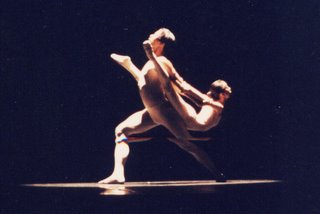 (paul with iya in photo from the 1995 season)
(paul with iya in photo from the 1995 season)After an absence of more than 10 years from the Philippine Ballet Theater, I had the rare pleasure of revisiting my past when we danced at the recent 20th anniversary Gala of the PBT. The vantage of time spent outside the company afforded me a special peephole to review my time at the PBT; the factors that brought me there in the first place, revisiting the season I performed with them and finally to ruminate on the company and the art of dance that has enthralled so many like me.
In truth the dance world in
As a young scholar of dance I had the opportunity to observe and admire the dancers who were already performing at that time. This included the dancers who were part of the newly formed PBT or would figure prominently in the company in the future. In my first ballet class I was simply dumbfounded, trying to follow the complicated dancing that was explained just by their names! It seemed an impossible task. I watched the other dancers for inspiration including Katrina Santos, a ballerina I would come to greatly admire for her elegance and drama, (her Juliet to Osias Barroso’s Romeo for PBT, which I saw in a matinee is still a distinct highlight in my dance memory) and hoped that I too could one day perform the intricate footwork.
My pursuit of dance led me to being a scholar at the CCP dance school and eventually a member of the first batch of Ballet
In contemporary dance training the study of ballet is included, but is not the basis for the technique and aesthetics. This allows a lot of dancers without ballet training to excel in the field. Returning to
It was 1995, the year of the great migration of dancers from the PBT to form Ballet Manila which in turn opened up opportunities for dancers like me to join the company despite not training there. Ballet companies are notoriously hierarchical; one was always expected to go up the ranks, from scholar to apprentice to member and so forth. It seems we were just taking class at the right place at the right place. It wasn’t a conscious decision, more a fortuitous turn of events. Still we only bolstered the considerable talent already present at the company. Among the members who joined the company at the time with me include Ron Jenario and Kit Sanchez, dancers whose dedication to the art, staying on with the company in the intervening years, would be rewarded by their eventually assuming leading parts in the company. In this aspect dance even from a spectator’s point of view can be very fulfilling, observing how dancers grow and mature over time.
Anatoli Panisukov had joined the company as ballet master at about the time we did and it is truly amazing how he was able to produce arguably the best classical dancers presently dancing in Abigail and Jared Tan. Their consecutive victory at the NAMCYA competitions is a testament to the long process making dancers, and the exemplary quality of Anatoli’s training.
What is disheartening is the state of the company, the lack of dancers and the seemingly dwindling audience. Many fine dancers have been produced only to be lost to more ‘profitable’ careers. The dancers themselves have always felt that perhaps with the backbreaking work involved with staging ballet, perhaps a better mechanism for marketing could be also be prioritized. From the dancers to the dance parents; a truly professionalized management style that honors the dancers work is still being hoped for. Indeed, how can we share more of this magic of ballet to a greater number of people?
The amazing thing is that when the company invited the past members to perform they came back in droves, Guada even coming all the way from
Despite these misgivings, events like the anniversary are truly fulfilling. It links the younger dancers to their elder peers, (as they would have if more dancers stayed on) allowing them to witness and benefit from the advice and example of those that came before them. For me it was the pleasure simply of sharing that elusive stage again with great dancers who truly enjoy and shine in the dance.

No comments:
Post a Comment